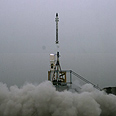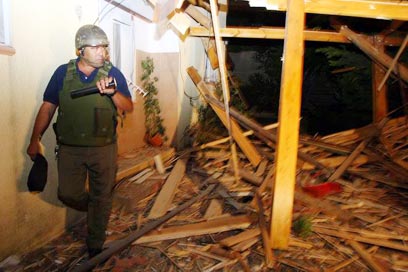
Missile shield: Is Israel safe?
Iron Dome system just one layer of multilayered missile defense system currently in works
In this context it's important to note that the IDF did not want the system. Even before the Second Lebanon War, and today as well, top army officials preferred to acquire offensive weapons systems and munitions that would enable the army to end wars quickly, while eliciting diplomatic results that would guarantee deterrence and quiet over time. According to this approach, civilians were to make do with the passive protection provided by secured rooms and bomb shelters, coupled with emergency assistance offered by authorities.
The revolutionary thinking that prompted Israel to develop its multilayered anti-rocket system resulted from public pressure exerted following the Lebanon, as well as the firm stance of then-Defense Minister Amir Peretz. His successor, Ehud Barak, is also known as an enthusiastic supporter of Iron Dome; eventually the army toed the line too.
All of the above prompted the current situation, whereby Israel possesses two-and-a-half of the five planned anti-missile defense "layers": The Arrow batteries, meant to intercept long-range ballistic missiles; the upgraded Patriot system, meant to serve as backup for the Arrow and to some extent offer protection against Cruise missiles – even though its capabilities on that front are yet to be proven; and now, the Iron Dome system, which was successfully tested but not yet deployed.
Yet on top of the above, a system that will play a critical role in Israel's anti-missile defense is being developed at this time – Magic Wand. It will aim to intercept heavy mid- and long-range rockets that possess great destructive potential and currently constitute the main danger posed to Israel's military and civilian home front nationwide.
The system, which is being developed by Israel's armaments authority, Rafael, is taking shape in cooperation with US-based Raytheon, and will not be completed before 2012. This system will be joined by the futuristic Arrow 3 missile (also known as "Super Arrow") which is already under development and is meant to intercept ballistic missiles originating from Syria and Iran in space. Arrow 3 will also be operationally ready only a few years from now.
IDF prefers ground ops
Today too, the army prefers to acquire offensive systems that in addition to ending wars quicker can address long-range missiles and rockets fitted with high-powered warheads. Because of their size and preparations required before using them, these missiles are considered relatively easy to spot and destroy using accurate munitions.
Yet in respect to the "light" short-range rockets, which in the past decade constituted a real nuisance for southern residents, IDF officials decided there was no point in wasting limited Air Force and intelligence resources in an effort to "hunt down" every rocket and launcher hidden in the bushes or in residential homes in southern Lebanon. In the army's view, the best way to handle such rockets would be through the current IDF doctrine, via ground operations that include the takeover of launch sites, thereby pushing back rocket cells beyond their effective range.

Lebanon War rocket attack aftermath (Photo: Hagai Aharon)
However, this leaves the issue of the fate of communities and vital facilities in northern and southern Israel. These regions, located within a 70-kilomters radius of Lebanon and the Gaza Strip, will be forced to sustain barrages of hundreds of rockets and missiles while the IDF goes on the offensive to curb the fire – this could last a week or more.
The IDF justifies its policy by arguing that the damages caused by short-range rockets are relatively minor. Among other things, this is the result of their flawed accuracy; in the Second Lebanon War, about 80% of the 4,000 rockets fired by Hezbollah landed in open areas. On top of it, such rockets can only carry a very small warhead, whose potential damage is limited.
Despite the above, there is no doubt that things look different to the residents of Ashkelon, Kiryat Shmona, and Safed, who during the Second Lebanon War and Operation Cast Lead were forced to stay in bomb shelters for long days for fear of rockets. This is why from a civilian point of view, quickly acquiring and deploying the Iron Dome system is immensely significant. Against this backdrop, we can understand why IDF officials continue to debate whether it would be proper to invest significant funds in the system, which does not help the army to end wars quickly and whose absence will mostly be felt on the moral level.
Drop in the ocean
In this context, and in order to set up an effective Iron Dome system that would provide the protection that northern and southern residents expect, at least 15 missile batteries, or even 20, must be deployed. This is because each battery can only provide proper defense for a relatively small area, such as medium-sized cities like Ashkelon, Safed and their neighboring communities, or an area that houses vital facilities such as the Haifa Bay refineries or large and isolated military bases.
The cost of all this will be very hard on the Israeli taxpayer, as each Iron Dome battery, including the accompanying radar systems and interception rocket stockpiles, is estimated at NIS 60 million – NIS 80 million (roughly $15.5 million - $20 million). The special aid pledged by US President Barack Obama stands at $205 million, and is enough for the acquisition of just eight or nine batteries. This may be the main reason for pessimism since, as it stands, the two batteries that the IDF has vowed will be operational within a year, are just a drop in the ocean. While they will be sufficient in the event of a local flare-up on the northern or southern front, this will not be the case in the event of an all-out war.
Therefore, it is imperative that political pressure be put on the defense establishment to accelerate the rate of acquiring and deploying the Iron Dome. Otherwise, the next war could catch us yet again in a situation where the civilian front is without active protection from light rockets.
It should be noted that the opponents' claims that this is would not be economic are baseless. While the cost of one intercepting missile for the Iron Dome system stands at some $50,000, compared to the Qassam and Grad rockets that range from $100 to 1,000$, the system was meticulously programmed not to waste its resources by intercepting the hundreds of rockets and mortar shells that find their way into open areas without posing any danger. These missiles will only be put into use when the fire-control radar identifies a threat to a populated area or a site housing vital facilities.
Cost-benefit analysis
Besides these calculations, the cost-benefit analysis should include not just the technical costs, but also the cost in human life and injures, the estimated funds it will take to rebuild the destruction and the compensation the State will have to pay in the event that rockets are not intercepted and damage homes or educational institutions.These scenarios highlight exactly why the development of the Magic Wand interception system should be expedited, so that the Israeli home front, both civilian and military, receives effective protection from heavy and long-range missiles sooner rather than later. Here, the need is not mainly civilian as in the case of Iron Dome, but is also military. The IDF and defense establishment are in no hurry to develop them.
Of course, the IDF's budgetary and operational dilemmas in the face of the public demand for a multilayer rocket and missile interception system must be taken into account. However, while the issue is not at the top of the military's priority list, it should still be appropriately promoted in the decision-making processes. The defense establishment and the government must decide on the rate of development and deployment of the interception systems and implement the decisions as quickly as possible.
Otherwise, instead of benefiting from Iron Dome and similar systems in the next war, Israel's leaders will once again be resorting to fairytales to provide a satisfying explanation for leaving the home front exposed and vulnerable.
- Follow Ynetnews on Facebook










